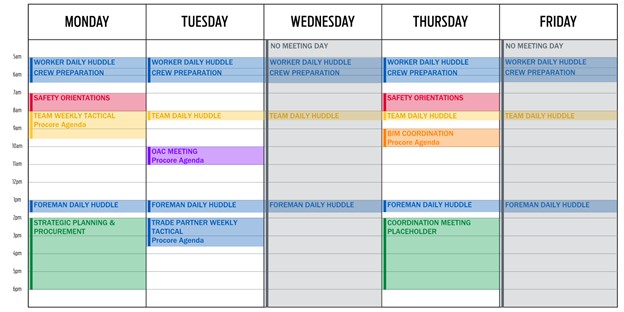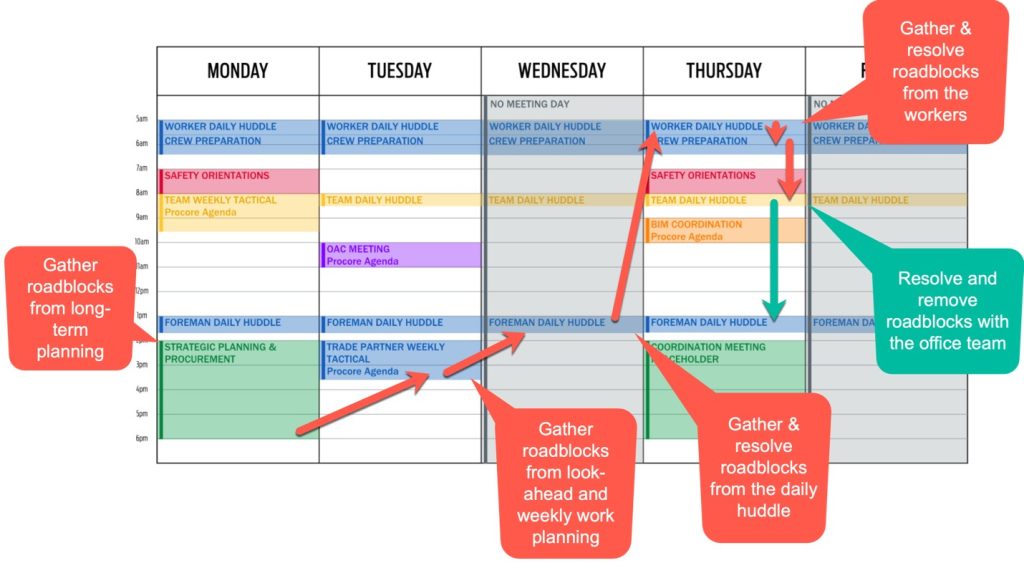Welcome back to the blog series where we will illustrate how Takt and Last Planner® work together to support the creation of flow on projects. In this blog and the one that came before it (parts 1 and 2) I will help you learn how to level work in a Takt-ed system.
This is part 2. Let’s get started!!!
Today. I am sharing a complete rundown of the recommended meeting system in case you want to reference it as a structure to implement Takt control. This is meant to accompany part 1, which you should read first in case you haven’t. It can be found here.
The Meeting System in Takt Control
In order to scale the common strategies and tactics of Takt control, a meeting system must be in place. Below is a minimum standard for a Takt control meeting system:
Standard Meeting Schedule:
Standard Meeting Flow:
Standard Meeting System Detail:
The Strategic Planning and Procurement Meeting (Schedule Update Meeting)
The purpose of the planning and procurement meeting is to enact long-term strategic planning for the project team so hey can check, manage, and update the Takt plan, refine Takt sequences from pull plans, and ensure that they have the procurement tracking to the right dates. This will be done with the project superintendent, project manager and the scheduler, if applicable. The agenda for this is as follows:
- Discuss any delays and impacts.
- Update the status of last week’s activities.
- Update Procurement Alignment. Updating any procurement system is critical. Procurement must be a scientific and artful approach. If we can get the materials on the project site, we can build it.
- Analyze bottlenecks.
- Check milestone alignment with current progress.
- The three to twelve-week look-ahead review must ensure that everything is being made ready for information, equipment, workers, materials, and safety preparation. This is done directly from the Takt plan.
After this meeting, you should be able to publish the current version of the project Takt plan. Reminders for weekly schedule updates are listed below. Consider these steps before you send out the update:
Pre-distribution tasks:
- Update status of JHA preparation
- Update past week’s activities
- Review the next six weeks in the schedule from pull plans
- Add in owner activities
- Add in pre-construction meetings
- Review material delivery dates
- Format any time impact analyses
- Analyze make-ready for next 6 weeks
- Plan for 90-day, 120-day, and long-term phase verification
- Review and/or enter in planning buffers
- Grade contractors for schedule update
- Suggested items to distribute:
- Current Takt plan
- Current Takt zone maps
- Current logistics drawings
- Provide project updates
- Provide contractor grading summary
- Provide monthly narrative if applicable
- Insert any new planning from either changes or new design packages or phases
The result of this meeting is that the team is able to plan and prepare future work and communicate it to the trades in the schedule update.
The key items to notice when using a Takt Plan are:
- How is production going?
- Is it on track today or this week?
- Is work planned for tomorrow or next week?
- Do we still have enough buffers?
- Where are we in relation to the end date?
- Do we still have the right percentages of flow?
- What preparation work steps are important now to prepare for work?
- What roadblocks need to be removed or absorbed?
- Is work being made ready?
- Are separate phases on track to support each other?
- Is the schedule networked to create a complete plan?
- Is work pushing into problematic weather times?
- Are current production rates and cycle times projecting correctly throughout the schedule?
This prepares nicely for the…
Trade Partner Weekly Tactical (Weekly Work Planning Meeting)
The purpose of the trade partner weekly tactical is to plan for the Takt production taking place next week. The meeting is very effective because the Takt plan can be reviewed by the team and the focus can be on the removal of roadblocks and roadblock maps in the meeting. This will be done with the project superintendent, all site foremen, assistant supers, field engineers, and field support team. The key is to plan for next week by clearing the path. The agenda for this meeting includes the following:
- Positive shout-outs: Begin with two to four positive comments to begin the meeting in an awesome way.
- Lightning round: The lightning round is described in Patrick Lencioni’s book, Death By Meeting: A Leadership Fable About Solving The Most Painful Problem in Business and consists of a collection of bullet point agenda items obtained by going around the room and giving each person thirty seconds to make agenda additions for the meeting. The leader of the meeting then makes sure the most critical items are done within the allotted amount of time.
- General safety: Discuss safety as your number one value on the project site and within the team.
- Review Takt plan: Review the overall Takt plan to understand the progression of the project.
Takt Plan:
- Review last week’s progress.
- Review current progress to ensure everything is on track.
- Review the roadblock maps. Review all areas where work is taking place next week and focus as a team on the removal of roadblocks.
Roadblock Maps:
- Review key milestones. Review the key milestones of the project that will get people thinking about roadblocks. Make sure that there’s alignment in your meeting.
- If you choose to, you may include the creation of a weekly work plan or the planning of a Scrum sprint in this meeting. If you do, the work steps from the work packages that are included in next week’s Takt time can be easily selected and placed in the WWP or sprint backlog. The trade foremen can then collaborate on the plan for the week.
- Review Plus/Delta. Reflect with the team on the good parts of the meeting and what should be done differently in the future to make for a more remarkable meeting.
In this meeting, the Last Planner® System or Scrum can either take over detailed planning or simply the planning needed for non-typical areas. This queues up information for the…
Afternoon Foremen Huddle (Daily Huddle)
The purpose of an afternoon foremen huddle is to plan the next day with all of the last planners who are onsite. Make sure that the path to success for the next day is 100% clear and represented visually for the entire project. This will be done with the project superintendent, site foreman, assistant superintendents, field engineers and field support team members. The agenda is as follows:
- Positive shout-outs.
- Lightning round.
- Review of roadblocks.
- How did we do yesterday and today? Check the status of work as progressing throughout the week.
- Discuss what winning looks like for today or tomorrow. Review the weekly work plan. Detail every portion of tomorrow’s general plan for the foremen and superintendents. This should be communicated visually and represent an understanding of general items.
- What is the safety focus for tomorrow?
- Logistics. What is coming? When? Where will it go? It is key not to write anything on the board or allow any deliveries unless you know exactly where it will be staged.
- Inspections?
- Safety observations. Share what was found and whether the previous day’s items are closed out. If items are not closed out, crews should fix these BEFORE going to work. Drive them to closure.
- Permits. Ask if anyone needs permits and then point them to the person/location to get them immediately after the huddle.
- Weather. Address weather conditions for tomorrow.
- Review Plus/Delta
- Departure. Leave with the information in one location.
- To implement a high level of production control, foremen should update their production status from that day and create their production plan for the next before leaving.
Note: You will status the Takt plan as you go on a weekly or daily basis. You can do this in a number of ways.
 Foremen Huddle Picture:
Foremen Huddle Picture:
 Morning Worker Huddles
Morning Worker Huddles
The purpose of the morning worker huddle is to create a social group with all workers onsite and win them over to project standards and communicate the plan for the day—particularly the safety plan for the day. This will be done with the project superintendent, site foremen, assistant superintendents, field engineers, field support team members, and ALL workers onsite. The agenda for this is as follows:
- Give shout-outs.
- Request feedback from workers.
- Review the plan for the day in an abbreviated format.
- Define safety focus for the day.
- Review safety observations from the previous day’s reflection walk.
- Share what was found and ask if the previous day’s items are closed out. If not, crews should fix these BEFORE going to work. Drive them to closure.
- Address any owner items.
- Reiterate need for cleanliness and organization.
- Ask if anyone needs permits and then point them to the person/location to get them immediately after the huddle.
- Review deliveries and strategy.
- Review training for the day.
- Address weather conditions for the day.
- Encourage crew preparation huddles.
- Reinforce the need for PTPs.
Crew Preparation Huddles
The purpose of the crew preparation huddle is to prepare the crew for the work. If the first planners prepare the Takt plan with the foremen, the foremen, or last planners prepare the commitments on a production level, then the workers carry out that plan and need to be prepared. The crew preparation huddle takes place right after the worker huddle on the floor, area, or building where that crew is working. This will be done with foremen for that crew and crew workers working with that foreman. This is an opportunity for the foremen to line out the workers in a remarkable way to execute the work.
Agenda: (15-25 Min.)
- Positive shout-outs.
- Safety training topic.
- Standard work step documentation review.
- Share 2 Second Lean improvements from the day before.
- Walk area of work and plan for safety.
- Fill out PTPs, orient, and sign.
- 5S work area while foremen are filling out PTPs
- Sort
- Set in order
- Shine/sweep
- Standardize
- Sustain/self-discipline.
- Setup work area for success by eliminating the 8 Wastes particularly,
- Excess material inventory
- Wasted transport
- Wasted motion
- Treasure hunts. Gather all tools and needed equipment to prevent treasure hunts.
- Safe off work areas.
- Go to work and execute according to standard work steps.
Production Control
The meeting system is designed to scale communication from the first planners through, to, and past the last planners to the workers. No plan is well-supported unless there is a system to get it all the way to the people installing the work. Really, Takt is the best first planner system, and the system used for last planners can be either Takt control, Last Planner®, or Scrum. If you are on a megaproject, you can break out your meeting system by functional area and have your huddles (foremen huddle, worker huddle, crew preparation huddle) separated by interiors, basement, exterior, and site, or by building A, B, and C. There is so much flexibility with the system.
In short, that meeting system allows a collaborative team to plan, commit, execute, and adjust the plan. But no plan will remain the same—it will need adjustment. That is why we implement Takt control with leveled work.
I hope you all enjoyed this week’s blog post about leveling work. Stay with us next time as we discussion labor productivity with production laws.
















